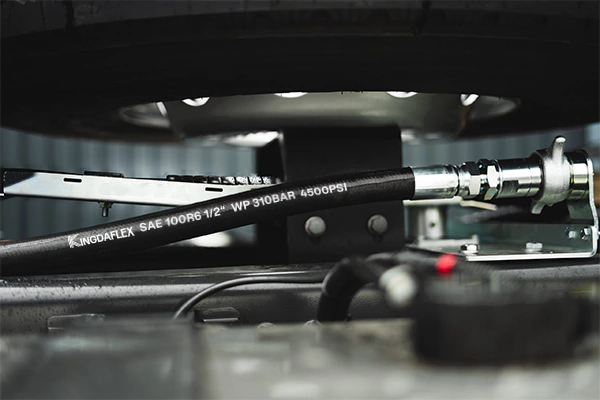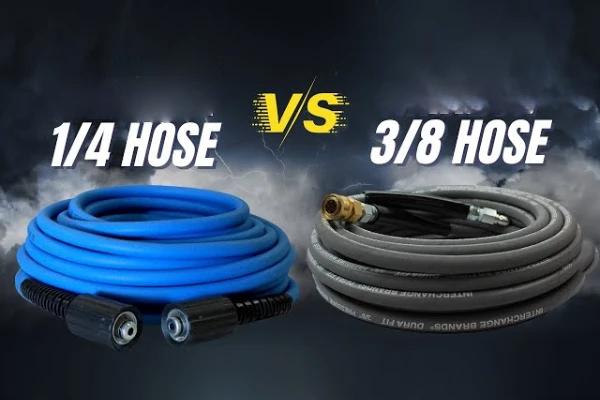Hydraulic systems are the beating heart of heavy machinery and equipment, powering everything from construction equipment to manufacturing machines. At the core of these systems are hydraulic hose components, which are vital to their proper function.
In this article, we will delve into the world of hydraulic hose components, exploring their importance, types, maintenance, and more.
Understanding Hydraulic Hose Components
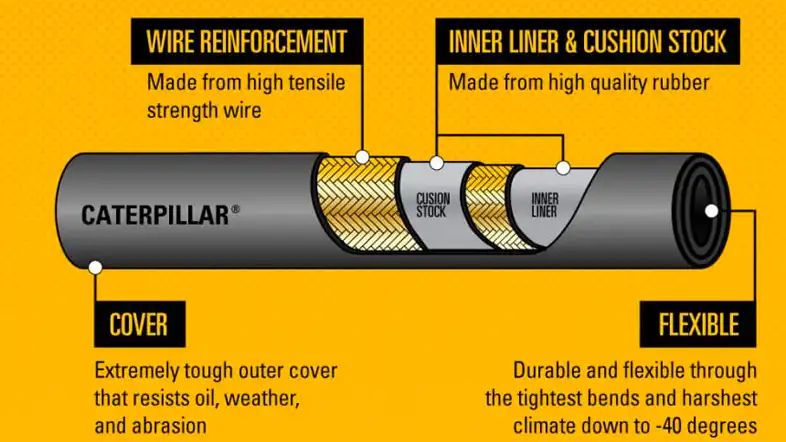
Let’s delve further into the topic of “Understanding Hydraulic Hose Components.”
Hydraulic hose components are the fundamental building blocks of hydraulic systems, playing a pivotal role in transmitting hydraulic fluid under pressure. Understanding these components is crucial for anyone working with hydraulic machinery, as it ensures the safe and efficient operation of these systems.
Inner Tube:
The inner tube is at the core of the hydraulic hose and is the component that directly comes into contact with the hydraulic fluid. It must be selected carefully to be compatible with the specific type of fluid used in the system.
Common materials used for inner tubes include synthetic rubber, thermoplastic, and Teflon. The choice of material depends on factors like the type of hydraulic fluid, temperature, and pressure.
The reinforcement layer provides structural support to the hose, preventing it from collapsing under high-pressure conditions. It’s a critical component for maintaining the hose’s integrity.
Reinforcement layers are typically made from materials such as braided wire, spiral-wound wire, or textiles. The choice of reinforcement depends on the required pressure rating and flexibility.
Outer Cover:
The outer cover of the hydraulic hose serves as a protective barrier, shielding the hose from external elements, abrasion, and damage. It also contributes to the overall flexibility of the hose.
Outer covers can be made from synthetic rubber, thermoplastic, or hybrid materials, depending on the specific application and environmental conditions.
In essence, the inner tube carries the hydraulic fluid, the reinforcement layer provides strength to withstand high pressures, and the outer cover protects the hose from external factors. These components work in harmony to ensure that hydraulic systems operate smoothly and reliably.
Understanding the materials and construction of hydraulic hose components is vital for selecting the right hose for a particular application. Choosing the wrong hydraulic hose can result in inefficiencies, safety hazards, and potential damage to the entire hydraulic system.
Therefore, when working with hydraulic machinery, it’s essential to be knowledgeable about the intricacies of hydraulic hose components to make informed decisions regarding maintenance, replacement, and troubleshooting.
Related:
Importance of Hydraulic Hoses

Hydraulic hoses are often described as the lifelines of machinery and for a good reason. They play a critical role in hydraulic systems, which are widely used in various industries, including construction, manufacturing, agriculture, and aerospace.
Here’s why hydraulic hoses are indispensable:
Power Transmission:
Hydraulic hoses are responsible for transmitting hydraulic fluid under pressure. This fluid carries the power required to operate different components of machinery, such as cylinders, motors, and pumps. In essence, hydraulic hoses act as the conveyors of energy within the system.
Versatility:
Hydraulic systems are versatile and can be found in a broad range of applications, from the heavy lifting machinery used in construction to the precision controls of medical devices. Hydraulic hoses allow these systems to perform diverse tasks efficiently.
Control and Precision:
Hydraulic systems offer precise control over movements and actions. They can smoothly and accurately control the speed and force, making them ideal for delicate tasks like surgical equipment and rugged operations like mining machinery.
Efficiency and Productivity:
Hydraulic systems, enabled by hydraulic hoses, are known for their efficiency. They can deliver a high amount of power using relatively small components, resulting in equipment that is both compact and productive.
Reliability:
When maintained and used correctly, hydraulic hoses and systems are incredibly reliable. They can withstand challenging conditions, including high pressure and temperature variations, without compromising their performance.
Safety:
Hydraulic systems, including their hoses, are designed with safety in mind. They can operate at a distance from the actual work site, reducing the risk to operators. Additionally, hydraulic systems often have fail-safes to prevent catastrophic failures.
Cost-Effective:
While the initial investment in hydraulic machinery and hoses might be higher than some alternatives, their long-term cost-effectiveness is outstanding. They require minimal maintenance and have a long lifespan, reducing downtime and replacement costs. Hydraulic Hose Cost: How Much You Need to Spend on Hydraulic Hose?
The Consequences of Neglect
Conversely, neglecting the importance of hydraulic hoses can lead to various issues, including:
- Downtime: When hydraulic hoses fail due to wear and tear or damage, it can result in costly downtime for businesses, as machinery becomes inoperative until repairs are made.
- Safety Hazards: A damaged or leaking hydraulic hose can pose safety risks to operators and the environment. Hydraulic fluid escaping under high pressure can cause serious injuries and damage.
- Reduced Efficiency: Poorly maintained hydraulic hoses can lead to decreased efficiency in machinery. This inefficiency can result in wasted energy and higher operational costs.
- Environmental Impact: Leaking hydraulic fluid can harm the environment by contaminating soil and water sources. Environmental regulations often require responsible fluid handling.
In summary, hydraulic hoses are fundamental components of hydraulic systems that power many industries. They enable the efficient transmission of energy, control, and precision, making them essential for a wide range of applications. Proper maintenance and understanding of their importance are key to ensuring the longevity and reliability of hydraulic systems.
Hydraulic Hose End Fittings
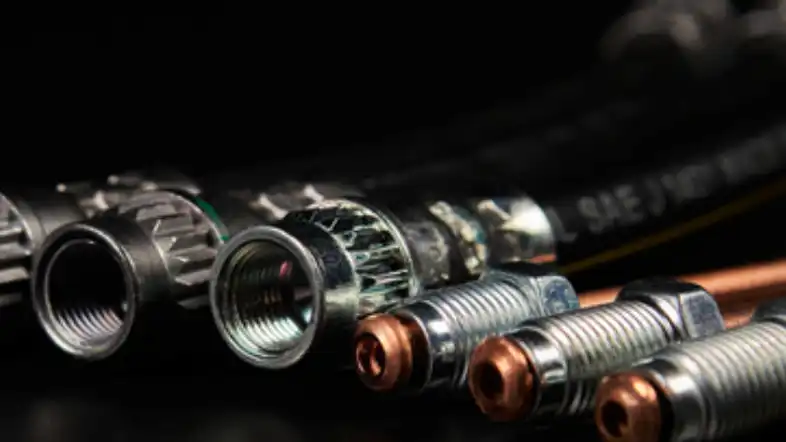
End fittings are crucial for connecting the hydraulic hose to other components in the system. They come in various types, including flanges, couplings, and quick-connect fittings. Selecting the right end fittings is essential to prevent leaks and ensure a secure connection.
Selecting the Right Hydraulic Hose
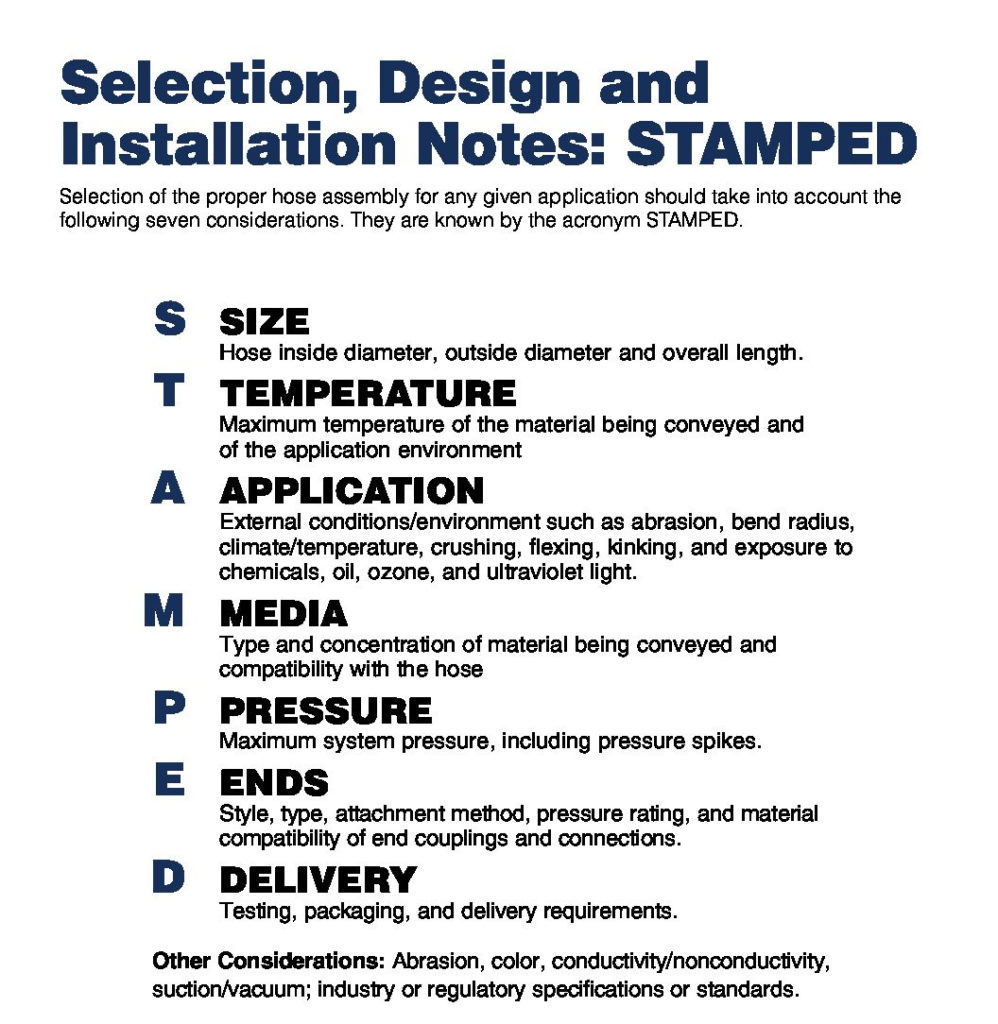
Selecting the right hydraulic hose is a critical decision in ensuring the optimal performance and safety of your hydraulic system. Hydraulic hoses come in various types, each suited to different applications and conditions. Making the correct choice involves considering several key factors:
Operating Pressure:
The first and foremost consideration is the operating pressure of your hydraulic system. Hoses are designed to handle specific pressure ranges. Select a hose that can withstand the maximum pressure your system generates. It’s essential to ensure the hose’s working pressure rating exceeds the maximum pressure in your system to prevent hose failure.
Temperature Range:
Hydraulic systems often operate in a wide range of temperatures. Hoses have temperature ratings that indicate the minimum and maximum temperatures they can handle effectively. Choose a hose with a temperature rating compatible with your system’s operating conditions. Extreme temperatures can cause hoses to become brittle or soft, leading to failure.
Fluid Compatibility:
Hydraulic hoses must be compatible with the hydraulic fluid they will carry. Different fluids have different chemical properties that can affect hose materials. Consult the manufacturer’s recommendations or industry standards to select a hose that is chemically compatible with your hydraulic fluid. Incompatible hoses can lead to deterioration and leakage.
Bend Radius:
Consider the minimum bend radius of the hose. The bend radius is the minimum curvature that a hose can safely handle without causing kinking or damage. Using a hose with a bend radius smaller than required can lead to reduced hose life and performance issues.
Hydraulic Hose Size:
The size of the hose, often expressed in terms of its inside diameter, affects the flow rate and pressure drop in the hydraulic system. Ensure the hose size is appropriate for the flow rate and pressure requirements of your equipment.
End Fittings:
Selecting the right end fittings is crucial. They are responsible for connecting the hose to other components in the system, such as pumps, valves, and cylinders. Ensure that the end fittings match the hose and the connecting components and that they provide a leak-free connection.
Hydraulic Hose Application
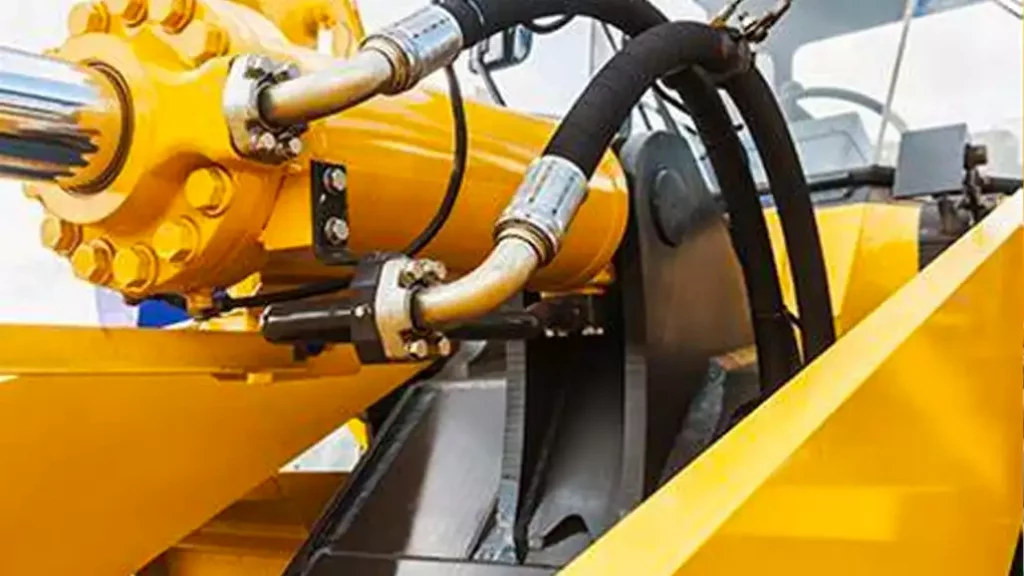
Consider the specific application and environment where the hydraulic hose will be used.
For example, in abrasive environments, a more rugged and durable hose may be needed. In applications where flexibility is crucial, a hose designed for flexibility might be preferred.
Hose Construction:
Different hoses have varying construction materials, including the inner tube, reinforcement layer, and outer cover. The choice of construction materials depends on factors like the type of hydraulic fluid used, the environmental conditions, and the application’s demands.
Regulatory Compliance:
Ensure that the chosen hose complies with industry standards and regulations. Compliance ensures safety and reliability in your hydraulic system.
Budget Considerations:
While it’s crucial to prioritize quality and performance, consider your budget. High-quality hoses may have a higher upfront cost but can offer long-term cost savings due to reduced maintenance and downtime.
Selecting the right hydraulic hose is a pivotal decision that directly impacts the efficiency and safety of your hydraulic system. By carefully evaluating factors like operating pressure, temperature range, fluid compatibility, and application-specific requirements, you can choose the ideal hose for your machinery or equipment, ensuring reliable and trouble-free operation.
Proper Hydraulic Hose Installation and Maintenance
Proper installation and maintenance of hydraulic hoses are essential for ensuring the longevity, efficiency, and safety of your hydraulic system. Neglecting these aspects can lead to costly downtime, increased safety risks, and reduced system performance. Here’s a detailed guide on how to correctly install and maintain your hydraulic hoses:
Hydraulic Hose Installation:
- Preparation: Before installation, thoroughly inspect the new hose, fittings, and the area where you’ll be installing it. Ensure the work environment is clean, free from debris, and well-ventilated.
- Cutting the Hose: Use a hydraulic hose-cutting machine or a fine-toothed hacksaw to cut the hose to the required length. Ensure a clean, perpendicular cut to prevent leaks.
- Fitting Selection: Choose the appropriate end fittings for your application. Match the fitting to the hose and the component you’re connecting. Ensure the fittings are clean and free from damage.
- Assembly: Lubricate the hose and the fitting threads with hydraulic fluid. Assemble the fittings to the hose, ensuring they are correctly aligned and tightened to the manufacturer’s specifications.
- Routing and Clamping: Route the hose so that it doesn’t twist or kink during operation. Use clamps to secure the hose at regular intervals, keeping it clear of sharp edges, moving parts, and heat sources. Avoid excessive bending and ensure the hose has the necessary slack for movement.
- Torque: Tighten fittings to the recommended torque values to prevent leakage and ensure a secure connection. Over-tightening can damage the hose, while under-tightening can lead to leaks.
- Pressure Testing: After installation, perform a pressure test to check for leaks or other issues. Monitor the system closely during this test to ensure there are no sudden failures.
Maintenance:
- Regular Inspections: Schedule regular visual inspections of your hydraulic hoses. Look for signs of wear, damage, or leaks. Pay particular attention to areas near fittings, as they are prone to stress.
- Cleaning: Keep hoses clean and free from contaminants. Dirt, oil, and debris can damage the outer cover or clog the hose’s interior. Use a cloth or compressed air to remove surface contaminants.
- Storage: Properly store any spare hoses. Protect them from direct sunlight, extreme temperatures, and moisture. Hoses should be stored in a way that prevents kinking or bending.
- Replace Damaged Hoses: If you notice any damage during inspections, replace the hose immediately. Attempting repairs on a damaged hose is not recommended, as it may compromise safety.
- Maintenance Records: Maintain a record of each hydraulic hose’s installation date, last inspection, and any maintenance or replacement. This documentation helps in tracking the hoses’ lifespan and making informed decisions.
- Environmental Considerations: Be mindful of the environmental impact of hydraulic systems. Use eco-friendly hydraulic fluids when possible and handle any spills or leaks responsibly.
- Safety Training: Ensure that personnel handling hydraulic hoses are adequately trained in safety practices. They should know how to identify potential hazards and respond to emergencies.
- Consult the Manufacturer: Always refer to the hose and system manufacturer’s guidelines and recommendations for installation and maintenance. They are experts in their products and can provide specific instructions.
Proper installation and maintenance of hydraulic hoses are vital to ensure the safe and efficient operation of your hydraulic system. Regular inspections, correct installation practices, and adherence to manufacturer guidelines are key to preventing costly downtime and ensuring the longevity of your equipment.
Benefits of Hydraulic Hose Components
Hydraulic hose components play a critical role in ensuring efficient fluid power transmission in various systems. They enhance performance, safety, and reliability while reducing maintenance needs. By choosing high-quality components, you can optimize your hydraulic systems for long-lasting operation and consistent performance in demanding applications.
- Enhanced System Efficiency: Hydraulic hose components reduce friction and energy loss, ensuring smooth fluid flow, faster response times, and improved overall system performance, which leads to higher productivity and reduced operational costs.
- Durability and Longevity: Made from premium materials, these components resist wear, corrosion, and pressure-related damage, extending the service life of hoses and reducing the frequency of replacements and system downtime.
- Safety and Leak Prevention: Properly designed and installed hydraulic hose components prevent leaks, bursts, and accidents, protecting both operators and equipment while maintaining system integrity under high-pressure conditions.
- Versatility in Applications: These components can be used across diverse industries, including manufacturing, construction, and automotive, providing reliable connections for various hydraulic systems and meeting specific operational requirements.
- Ease of Maintenance: High-quality hose components simplify inspection, assembly, and replacement, reducing maintenance time and costs while ensuring the hydraulic system continues to operate efficiently and safely.
Conclusion
Hydraulic hose components are vital for maintaining the performance and reliability of your machinery. Investing in quality hoses and fittings ensures consistent fluid flow, prevents leaks, and supports safe, efficient operation in demanding environments. Proper care extends the life of both hoses and connected equipment.
Understanding the different types of hydraulic hose components and their functions helps you make informed choices. From hoses to connectors, each part contributes to the overall efficiency and durability of your hydraulic systems, reducing maintenance costs and preventing unexpected failures.
For wholesale hydraulic hoses, trust Kingdaflex. We provide durable, reliable hoses suitable for automotive, industrial, and hydraulic applications. Our bulk supply and customized solutions meet diverse operational needs, ensuring your machinery runs smoothly while maintaining optimal performance and safety standards.
FAQs
Are hydraulic hoses all the same?
Hydraulic hoses come in various types and sizes, each suited to different applications. It’s essential to choose the right one for your specific needs.
How often should I inspect my hydraulic hoses?
Regular inspections are crucial. Depending on usage and conditions, this could be monthly or more frequently.
What is the main cause of hydraulic hose failure?
The primary causes are wear and tear, high pressure, or damage from external factors.
Can I repair a damaged hydraulic hose, or should I replace it?
In most cases, it’s safer and more cost-effective to replace a damaged hose rather than attempting repairs.
What are the advantages of using eco-friendly hydraulic fluids?
Eco-friendly hydraulic fluids can reduce environmental impact and improve workplace safety. They are worth considering for many applications


